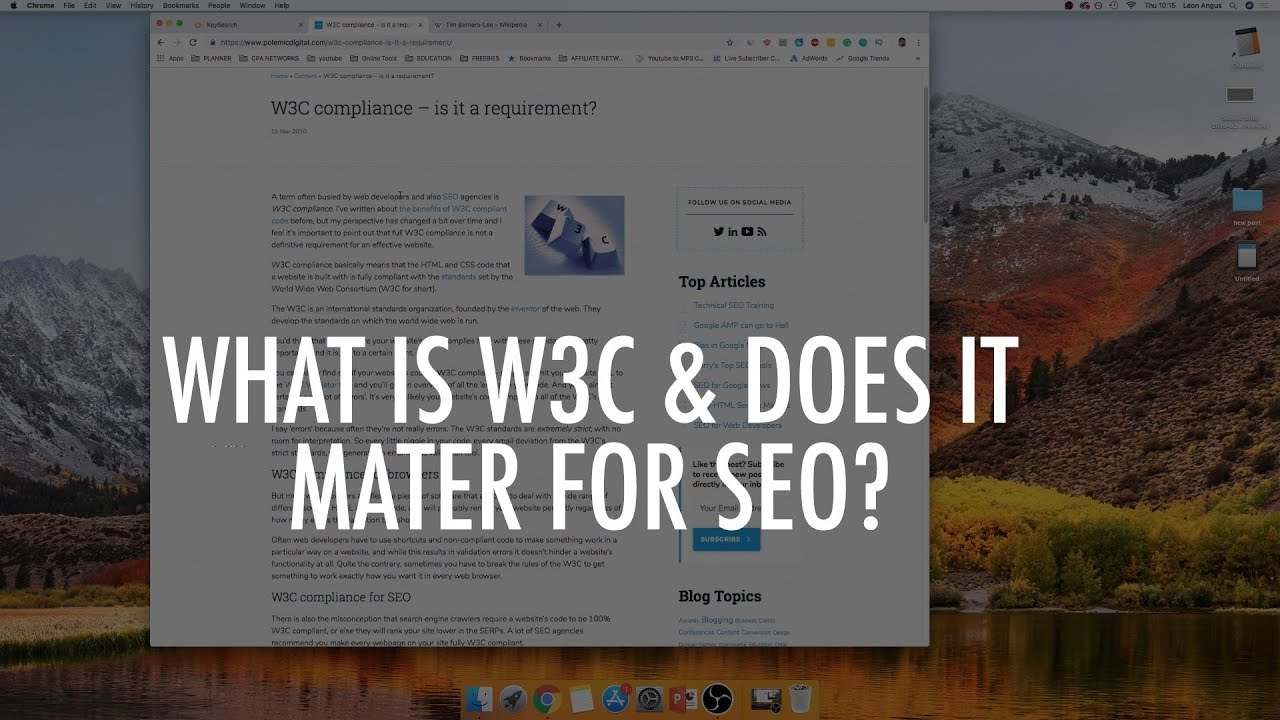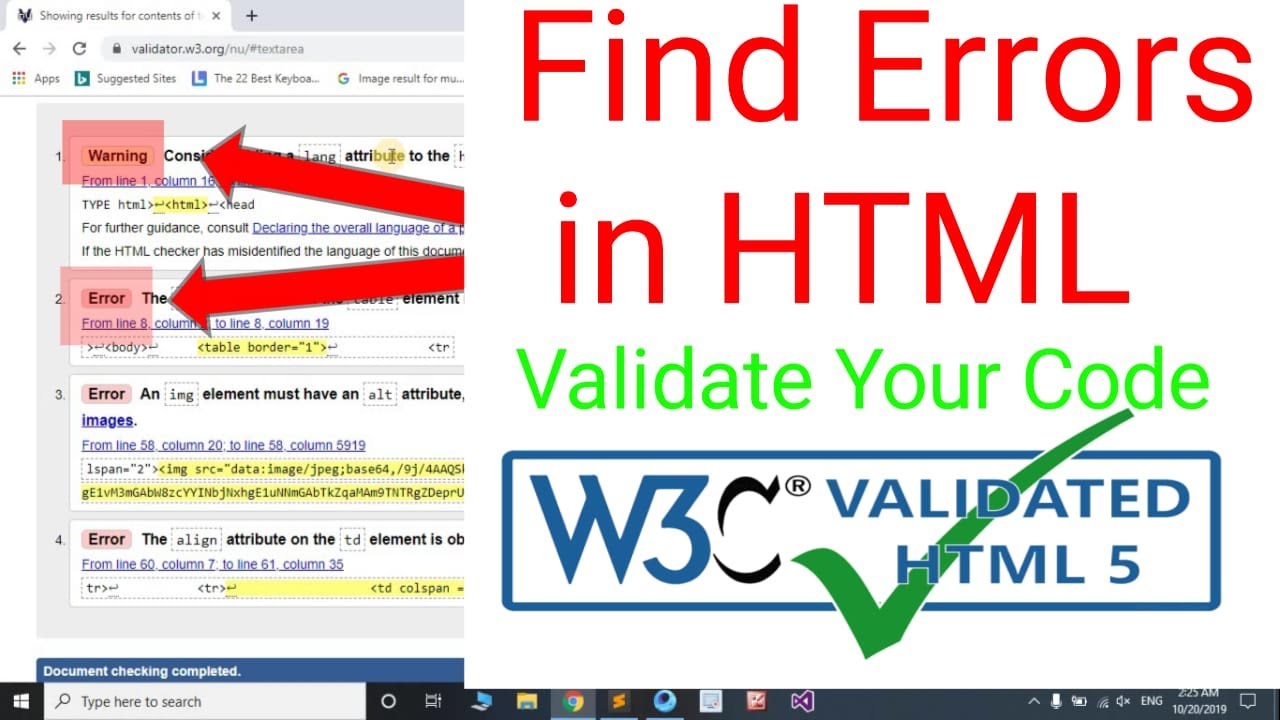In the rapidly evolving world of web development, adhering to established standards is essential to create websites that are both functional and user-friendly across a variety of platforms and devices. The World Wide Web Consortium (W3C) Validator stands as a beacon of quality assurance, offering developers a powerful tool to ensure their websites conform to these crucial standards. In this W3C Validator guide, we embark on a journey through the realm of the W3C Validator, exploring its significance, usage, and the benefits it brings to the art of crafting exceptional web experiences.
What Is W3C Validator?

What is W3C and W3C Validation ? Explained W3C
The W3C Validator, formally known as the Markup Validation Service, is a web-based tool developed by the World Wide Web Consortium (W3C). It plays a vital role in examining and validating the markup languages used to construct web pages, such as HTML, XHTML, and XML. The primary purpose of the W3C Validator is to ensure that websites adhere to established web standards, guidelines, and best practices.
When a web page is submitted to the W3C Validator, the tool scrutinizes the underlying code to identify errors, warnings, and suggestions related to compliance with these standards. It checks for correct syntax, proper use of elements and attributes, and adherence to structural guidelines. By doing so, the W3C Validator helps web developers and website owners create websites that are well-structured, consistent, and accessible across various browsers and devices.
Why Is W3C Validator Important For SEO?

What is w3c validation? And is it important for your niche site? | Leon Angus
The W3C Validator holds significant importance for Search Engine Optimization(SEO) due to its role in improving various aspects that can positively impact a website's search enginerankings and overall online visibility. While the W3C Validator itself is not a direct ranking factor, the benefits it provides contribute to a website's overall quality and user experience, which in turn can influence SEO. Here's why the W3C Validator is crucial for SEO:
- Code Quality and Efficiency -The Validator helps identify and rectify errors in your website's code, ensuring that it follows web standards and best practices. Clean, well-structured code tends to load faster, enhancing user experience. Faster-loading websites are favored by search engines, potentially leading to better search rankings.
- Cross-Browser Compatibility -Valid code is more likely to render consistently across different web browsers and devices. When your website functions well for users regardless of their chosen browser, it contributes to positive user experiences, which can indirectly influence SEO by reducing bounce rates and increasing user engagement.
- Accessibility for All Users -Valid code often translates to a more accessible website. Implementing web accessibilitypractices makes your site usable by individuals with disabilities, broadening your potential audience. Search engines appreciate websites that prioritize accessibility, which can lead to better search engine rankings.
- Crawler Understanding -Search engine crawlers navigate your website's code to index its content. Valid code is easier for these bots to interpret, ensuring that your content is accurately indexed and potentially improving your website's visibility in search engine results pages (SERPs).
- Positive User Experience -Valid code contributes to a seamless and consistent browsing experience. Users are more likely to engage with a website that loads quickly, functions properly, and provides accessible content. Positive user experience signals can indirectly influence SEO by reducing bounce rates and increasing time spent on the site.
- Mobile-Friendly Design -Valid code aligns with responsive and mobile-friendly design principles. With the increasing emphasis on mobile-friendliness as a ranking factor, a website that adapts well to various screen sizes and devices is more likely to perform better in search results.
- Future-Proofing -Following web standards through validation ensures that your website is prepared for future changes in technology and coding practices. This adaptability can prevent issues that might arise from outdated code, ensuring that your website remains relevant and functional.
How Does W3C Validation Work?
The W3C validation process involves analyzing your website's code to ensure that it adheres to established web standards and follows correct syntax. The World Wide Web Consortium (W3C) provides a tool called the Markup Validation Service, commonly known as the W3C Validator, to perform this analysis. Here's how the W3C validation process works:
- Submission of Code -You start by submitting the HTML, XHTML, or XML code of your web page to the W3C Validator. This can be done by either entering the URL of the web page or pasting the code directly into the Validator's interface.
- Markup Language Selection -You need to specify the markup language of your code. This ensures that the Validator checks your code based on the rules and specifications of the chosen language, whether it's HTML5, XHTML 1.0, or another version.
- Validation Options -The Validator provides different validation options, such as "Full" and "Quick" validation. Full validation checks both the document structure and CSS, while Quick validation focuses on the document structure only. You can choose the option that suits your needs.
- Validation Process -Once you click the "Check" or "Validate" button, the W3C Validator processes your code. It parses the code according to the rules of the selected markup language, analyzing the structure, elements, attributes, and their relationships.
- Error Detection -During the validation process, the Validator identifies various issues, such as syntax errors, missing or mismatched tags, incorrect attribute values, deprecated elements, and more. It categorizes these issues as errors, warnings, or information messages.
- Validation Report -After analyzing your code, the W3C Validator generates a validation report. This report provides a detailed summary of the issues found in your code. It includes information about the type of issue, the line number where the issue is located, and often a brief description of the problem.
- Interpreting the Report -You review the validation report to understand the errors, warnings, and suggestions provided by the Validator. The report helps you identify the areas of your code that need attention and improvement.
- Correction and Revalidation -Based on the validation report, you make the necessary corrections to your code to address the identified issues. This might involve fixing syntax errors, adding missing tags, correcting attribute values, and more. After making the changes, you revalidate your code to ensure that the issues have been resolved.
- Iterative Process -Code validation is often an iterative process. You may need to validate your code multiple times, making adjustments and revalidating until your code passes the validation process without errors or warnings.
How Do You Validate Your Code?

How To Validate Web site with W3C Validator
Validating your code involves using tools and services to check whether your markup (HTML, XHTML, XML) adheres to established web standards and follows correct syntax. One of the most commonly used tools for code validation is the W3C Validator (Markup Validation Service). Here's a step-by-step guide on how tovalidate your code using the W3C Validator:
- Access the W3C Validator -Open your web browser and navigate to the W3C Markup Validation Service.
- Choose Validation Method -You have two options for validating your code: you can either input a URL or paste your code directly into the text area provided on the Validator's webpage.
- Initiate Validation -Click the "Check" button to start the validation process. The W3C Validator will then analyze your code based on the selected markup language's specifications.
- Review Validation Results -After the validation process is complete, the Validator will generate a detailed report indicating any errors, warnings, and suggestions identified in your code. The results will be categorized for easier understanding.
- Address Issues -Review the validation report carefully to understand the issues identified by the Validator. The report will provide information about the location of errors or warnings within your code. Common issues might include missing closing tags, incorrect attributes, or malformed markup.
- Edit and Revalidate -Access your website's source code using a code editor and make the necessary corrections based on the Validator's suggestions. After making the changes, save your code and repeat the validation process to confirm that the issues have been resolved.
- Repeat as Needed -It's a good practice to periodically validate your code, especially when making significant updates to your website. Regular validation helps maintain code quality and ensures ongoing adherence to web standards.
Common Reasons Code Doesn’t Validate
Code validation is an essential step in web development to ensure that your markup adheres to established web standards. However, there are several common reasons why code might not validate. Here are some of the most frequent issues that can lead to validation errors:
- Missing or Mismatched Tags -One of the primary causes of validation errors is missing or improperly nested HTML tags. For example, forgetting to close a <div>tag or nesting block-level elements like <p>inside inline elements like <span>can result in validation issues.
- Incorrect Attribute Values -Providing incorrect or unsupported attribute values can lead to validation errors. This can include using invalid characters, missing required attributes, or using attributes that are not applicable to certain elements.
- Unclosed Elements -Failing to properly close HTML elements with their corresponding closing tags can trigger validation errors. Each opening tag should have a corresponding closing tag, and they should be nested correctly.
- Non-Existent Elements or Attributes -Using HTML elements or attributes that are not part of the specified HTML version can result in validation errors. It's important to use elements and attributes that are supported by the chosen markup language.
- Malformed or Invalid Markup -Syntax errors, such as using special characters without proper encoding or using improper character entities, can lead to validation issues. Proper encoding is important to ensure that special characters are displayed correctly.
- CSS or JavaScript Code in Markup - Mixing CSS or JavaScript code directly within your HTML markup can trigger validation errors. It's recommended to separate your styles and scripts into external files for cleaner and more valid code.
- Unescaped Special Characters -Special characters like <, >, and & should be properly escaped using their respective character entities (<, >, &) to avoid validation errors.
- Whitespace and Line Breaks -While HTML is forgiving when it comes to whitespace, excessive or inconsistent use of whitespace and line breaks can lead to validation errors. It's important to maintain consistent formatting.
- Deprecated Elements or Attributes -Using elements or attributes that have been deprecated in newer HTML versions can lead to validation errors. Always use the latest recommended elements and attributes.
- External Errors -Sometimes, validation errors can occur due to issues outside of the code you control, such as incorrect server configurations or third-party scripts that generate non-compliant markup.
Common Validation Errors
Here are some common validation errors that the W3C Validator or other markup validators often identify on web pages:
Unclosed Tags
Failure to close HTML tags with their corresponding closing tags can lead to validation errors. For example:
</div>
<p>This is a paragraph without a closing tag.
<div>
Mismatched Tags
Incorrectly nesting HTML tags or using mismatched opening and closing tags can result in validation errors. For instance:
</ol>
<li>Item 2
<li>Item 1
<ul>
Missing Attribute Values
Some HTML attributes require values. Omitting these values can lead to validation errors. For example:
<a href>Invalid Link</a>
Incorrect Attribute Names
Using incorrect or non-existent attribute names can trigger validation errors. For instance:
<img sorce="image.jpg" alt="An image">
Unsupported Elements Or Attributes
Using HTML elements or attributes that are not supported in the chosen markup language can result in validation errors. For example:
<center>This center tag is not supported in HTML5</center>
Improperly Nested Elements
Nesting block-level elements inside inline elements or vice versa can lead to validation errors. For example:
<p><div>This is an improperly nested element</div></p>
Unescaped Special Characters
Special characters like <, >, and &should be properly escaped using character entities. Not doing so can result in validation errors. For example:
<p>This is <b>bold</b> text</p>
Duplicate IDs
Using the same idattribute for multiple elements can lead to validation errors, as idattributes should be unique on a page. For instance:
<div id="section1">Section 1</div>
<div id="section1">Section 2</div>
Obsolete Elements Or Attributes
Using HTML elements or attributes that have been deprecated in newer HTML versions can result in validation errors. For example:
<font color="red">This font tag is deprecated</font>
Missing DOCTYPE Declaration
Not including a proper DOCTYPE declaration at the beginning of your HTML document can lead to validation errors. The DOCTYPE declaration specifies the document type and version being used.
How To Prevent These Errors?

How to find and fix error in HTML/how to validate HTML code to HTML5 with w3c validator
Preventing common validation errors involves adhering to best practices when writing your HTML, XHTML, or XML code. By following these guidelines, you can reduce the likelihood of encountering validation issues. Here's how to prevent the errors mentioned earlier:
Prevent Unclosed Tags
Always close HTML tags with their corresponding closing tags. For example:
</div>
<p>This is a paragraph with a closing tag.</p>
<div>
Prevent Mismatched Tags
Ensure that you properly nest HTML tags and use the correct closing tags. For instance:
</ul>
<li>Item 2</li>
<li>Item 1</li>
<ul>
Prevent Missing Attribute Values
Provide values for attributes that require them. For example:
<a href="https://example.com">Valid Link</a>
Prevent Incorrect Attribute Names
Use correct and valid attribute names for your elements. For instance:
<img src="image.jpg" alt="An image">
Prevent Unsupported Elements Or Attributes
Use elements and attributes that are supported in the chosen markup language, and avoid deprecated features.
Prevent Improperly Nested Elements
Ensure that you correctly nest your HTML elements, using block-level elements within other block-level elements and inline elements within other inline elements.
Prevent Unescaped Special Characters
Escape special characters using character entities. For example:
<p>This is <b>bold</b> text</p>
Prevent Duplicate IDs
Use unique idattributes for different elements. For instance:
<div id="section2">Section 2</div>
<div id="section1">Section 1</div>
Prevent Obsolete Elements Or Attributes
Avoid using deprecated elements or attributes. Instead, use modern alternatives or follow current best practices.
Prevent Missing DOCTYPE Declaration
Always include a proper DOCTYPE declaration at the beginning of your HTML document. This declaration helps browsers understand which version of HTML you're using.
People Also Ask
What Is The Purpose Of The W3C Validator?
The W3C Validator, or Markup Validation Service, is used to check if a web page's markup (HTML, XHTML, etc.) adheres to established web standards. It identifies errors, warnings, and suggestions for improvement, ensuring a consistent and accessible browsing experience.
How Do I Use The W3C Validator To Validate My Website?
To validate your website using the W3C Validator, go to the Validator's website, input your website URL or code, choose the appropriate markup language, select validation options, and click the "Check" button. The Validator will then provide a detailed report of errors, warnings, and suggestions.
What Are The Benefits Of Using The W3C Validator For My Website?
Using the W3C Validator offers benefits such as improved cross-browser compatibility, enhanced accessibility for users with disabilities, potential SEO improvements, and future-proofing your website against technological changes.
What Should I Do If The W3C Validator Shows Errors And Warnings For My Website?
Review the validation report to understand the issues. Locate the problematic code sections using the provided line numbers and descriptions. Edit your code to fix the identified errors and warnings, then revalidate your website to confirm the issues are resolved.
Can The W3C Validator Help With Search Engine Optimization (SEO)?
Yes, adhering to web standards using the W3C Validator can positively impact SEO. Clean and well-structured code can improve your website's search engine rankings and user experience, leading to better visibility and user engagement.
Conclusion
In an era where the internet has become an integral part of our lives, the importance of adhering to web standards cannot be overstated. The W3C Validator serves as a guiding light, illuminating the path toward creating websites that are not only visually appealing but also accessible, functional, and future-ready.
As we conclude our W3C Validator guide, remember that embracing this tool is more than a technical endeavor; it's a commitment to delivering web experiences that transcend boundaries and delight users across the digital landscape. So, whether you're a seasoned developer or a passionate website owner, let the W3C Validator be your companion in the pursuit of excellence on the web.
